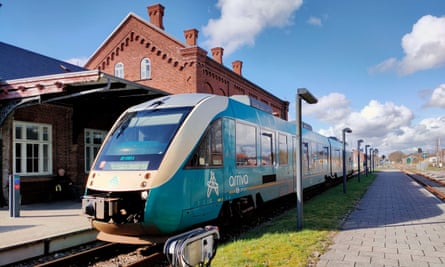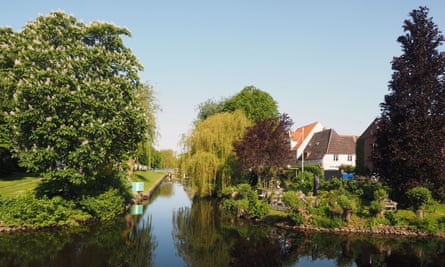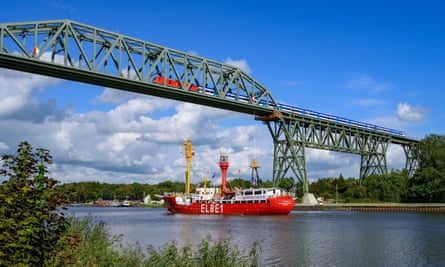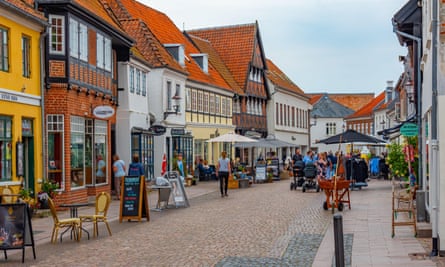
What makes a fine rail journey? We all have our own ideas on this, but I find it’s best not to dash and to retain an element of spontaneity, taking the chance to stop off here and there along the way. So, last month I ended up taking three days for a train journey of only 200 miles.
It’s possible to travel from Hamburg to Esbjerg by train in four to five hours with a single change of train at Niebüll, a small town in northern Germany just short of the Danish border. Yet, with fine early summer weather, this was a chance to dawdle. Except for short electrified stretches at either end – for the first 40 miles out of Hamburg and then again on the final few miles into Esbjerg – the route relies on diesel trains and for much of the way has all the character of a lightly used secondary railway. The appeal of the journey is in the delicate beauty of the flatlands and the fine small towns along the way.
The Marsh Railway
The slow train to Niebüll starts at Altona station in Hamburg. It’s an unloved terminus, now scheduled for redevelopment as part of a major urban renewal scheme. Rattling through Hamburg’s northern suburbs, we quickly gain open country with rich pastureland and bright yellow fields of oilseed rape. There’s plenty of water, too, a reminder that this area was drained by Dutch settlers in the high middle ages. This railway from Hamburg to the Danish border is called the Marschbahn (Marsh Railway).
We stop at country stations with tangles of early summer vegetation tumbling over the platforms. Crossing the River Stör at Itzehoe, we loop west over the Wilster marshes, gradually climbing on to a high embankment that affords views over the two-dimensional-looking Holstein landscapes. For the traveller unaware of what lies ahead, this skyward trajectory is one of the great enigmas of European rail travel. The great rise in elevation is necessitated by the railway crossing of the Kiel canal, which carries seagoing ships with high masts. This is as close as you’ll get to flying on a train, and it’s interesting to gaze down to the ferry shuttling cars over the canal far below.
Now, we are in Holstein cattle country, with riotous displays of gorse by the railway line, occasional windmills and wonderful lines of poplars. The sun comes out as we slip over the reed-fringed River Eider and, for the first time since leaving Hamburg, a station stop is announced bilingually, first in German and then in Frisian. “Friedrichstadt, Fräärstää.”
I love linguistic diversity and take it as an omen that this small town by the Eider might warrant a visit. Ambling by drainage ditches and over a canal bridge, I walk into Friedrichstadt’s compact town centre, which seems like the most amiable spot on Earth.

At first sight, this is a fragment of the Netherlands transposed into northern Germany, but the story of Friedrichstadt as a place of tolerance and peace transcends the community’s Dutch beginnings. There is more than a passing nod to the town’s heritage in modern Friedrichstadt. Apple pie aplenty, with hotel and restaurant names that play the Dutch card.
Remonstrants, Mennonites, Unitarians, Jews, Catholics and Quakers all settled in Friedrichstadt, taking advantage of a charter issued in 1623, giving freedom of belief in this small town in a region otherwise uniformly Lutheran. So taken am I by Friedrichstadt that I end up staying overnight (Pension Marktblick, doubles from €80, room-only), and then at mid-morning next day get back on a northbound train. I pause for lunch in Husum, a community shaped by herring fishing and with a welcome sweep of waterside cafes.

Crossing into Denmark
I continue to Niebüll where all passengers bound for Denmark must change trains. The summer-season through trains from Hamburg to Esbjerg are long gone. The onward train across the border is a comfortable modern railcar run by Arriva. We cruise north through marshy fenlands, swans enjoying the afternoon sunshine and make our first Danish stop at Tønder.
after newsletter promotion
The next place up the line is Ribe and, as we approach, it looks so appealing with its willows and hazel trees that I decide to break my journey again. There are cobbled streets and grass-grown lanes, myriad swallows and starlings, so to me Ribe is a delight. Super-size churches are a reminder that this town was once an important ecclesiastical centre. Today, it no longer makes the waves it once did. The silting up of waterways has changed the local landscape. The bustle of port trade has long gone, but Ribe is still a watery place. The splashing of mill wheels marks the Ribe soundscape.

This is a town that’s far too good to dismiss after an hour or two, so I stop overnight again (the family-run Hotel Ribe is a modest guesthouse with seven cosy rooms from €75). Travel outside the school holidays and, in small towns like Friedrichstadt and Ribe, it’s easy to stop off without much advance planning and find space in mid-range hotels.
On the third and final day of my journey to Esbjerg, I wake early and walk Ribe’s quiet streets. Then it’s breakfast and a visit to the Viking Museum (adults £12.60, under 18s free) right by the station. From here it’s just an hour to Esbjerg. “Only to Esbjerg?” queries the train manager as she checks my Interrail pass. “This train goes right through to Struer. With a pass you could go the whole way.”
I check the timetable and see that Struer is 33 stations further up the line beyond Esbjerg and takes another six hours. I’m tempted, but know that Esbjerg deserves an overnight stay. It’s a decision I don’t regret: for in the Danish port I find a town that is a wonderful example of sensible urban renewal with a good range of restaurants, which even on a summer day have candlelit tables and promise that Danish cosiness and conviviality known as hygge.
The fully flexible one-way fare from Hamburg-Altona to Esbjerg via Niebüll is €63.50, buy online via Deutsche Bahn or Rail Europe. A cheaper one-way fare of €42.50 is available only by telephone order from NAH.SH on 0049 431 660 19 449 (open 7am to 5pm UK time, Mon-Sat). These tickets allow stops but the entire journey must be completed without overnight stays. For real flexibility, follow the writer’s example and use an Interrail pass.
Nicky Gardner is the editor of Hidden Europe magazine and the co-author of Europe By Rail: The Definitive Guide, available from guardianbookshop.com



